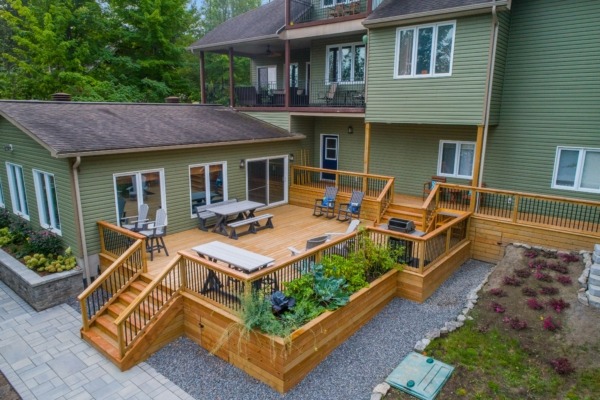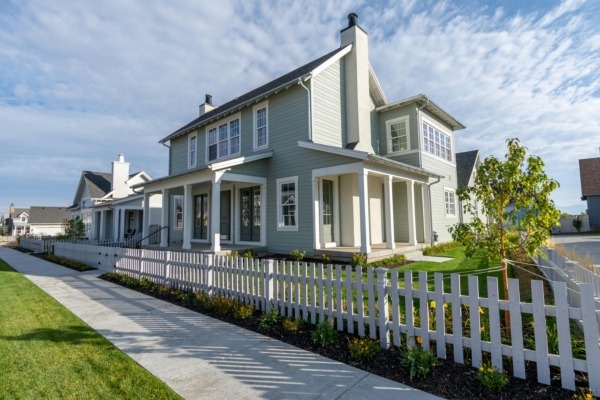Outdoor wood features like porch columns, deck posts, railings, and trim act like magnets for mold if they’re not properly protected. The mix of moisture, shade, and organic buildup creates an environment for mold and mildew to take hold. If this is left unchecked, mold can stain the surface, weaken the structure over time, and even attract unwanted pests.
The good news? It’s avoidable, with the right materials, design, and ongoing care, of course.
This guide covers why mold shows up on outdoor wood and how to keep it from becoming a recurring problem on your columns, balusters, railings, and more.
Why Mold Happens on Outdoor Wood
Mold spores are everywhere. All they need is moisture, darkness, and a food source (like dust or pollen) to thrive. When wood stays damp from rain, humidity, or contact with soil, mold will find a home. Once you add poor airflow and lack of sunlight to the mix, the problem accelerates.
Even pressure-treated or sealed wood can grow surface mold if water lingers too long. These treatments help slow the process, but they don’t make wood mold-proof.
Most Vulnerable Wood Components
Some exterior wood elements are especially mold-prone due to how they’re built or where they’re placed. The following list includes some examples of these elements, but it does not include all of them. Every one of them can develop surface mold, especially if they stay shaded or dirty.

Outdoor Wood Deck with Areas Prone to Mold Growth
Even a well-built backyard deck can be vulnerable to mold—especially in shaded areas, near ground contact, and where wood is unsealed or exposed to moisture.
How to Prevent Mold on Wood: Step-by-Step
Choose Rot-Resistant Wood
The best defense starts with choosing the right material to build with. Cedar, redwood, and cypress naturally perform well outdoors. Pressure-treated pine is strong and budget-friendly, but it will still need sealing to make the most of it. Whichever wood you use, make sure it’s appropriate for exterior conditions and not prone to soaking up moisture.
Seal It Properly
Think about applying a high-quality, exterior-grade sealant or paint. Look for UV blockers and water repellents. Coat all surfaces, including end grain, joints, and cut edges. Plan to reapply the sealant or paint every couple of years or whenever the finish shows signs of wear.
Keep Wood Elevated & Drained
You should never let wood sit directly on wet ground or concrete. Use plinth blocks or metal post bases to lift it up to reduce the amount of water it absorbs. Make sure surrounding areas are graded, so water flows away from the structure and not toward it.
Improve Airflow & Sunlight
Shade and stagnant air will naturally trap moisture. Whenever it’s a possibility, allow gaps around the base and sides of your columns or trim to promote ventilation. Trim back overgrown plants and trees that block sunlight from reaching and drying surfaces. Allowing even just a little extra airflow will make a big difference.
Clean Wood Regularly
Once or twice a year, try to clean all exposed wood surfaces that you’re concerned about. Using mild soap and water or a white vinegar solution will work fine for this. Avoid harsh chemicals like chlorine bleach. These chemicals can degrade the wood and harm the health of nearby landscaping. For heavy staining, use an oxygenated wood cleaner for best results.
Inspect Every Year
Plan to do a walkthrough one time per year to check for signs of mold or even deeper problems like rot. You’ll want to look for dark patches, soft spots, peeling paint, musty smells, or anything else that looks like a sign of mold. Detecting these issues early gives you the chance to clean, reseal, or make small repairs before bigger issues develop.
When to Replace vs. Restore
If mold is only found on the surface, a cleaning and reseal will usually bring the wood back to life. But, if you notice soft or spongy wood, deep cracking or splintering, or visible wood rot or instability, it’s time to replace. The mold might be a symptom of a deeper issue, especially around the base of posts or load-bearing parts.
When replacing, start fresh with a durable species and seal everything properly from the start. Elevate the wood, allow for airflow, and inspect it regularly.

Painted Wood Porch Columns with Proper Exposure to Sun and Airflow
These painted wood porch columns are well-positioned for mold prevention, with full sun exposure, airflow around the base, and elevation above soil contact—key factors for long-term durability.
How to Prevent Mold on Wood: Final Thoughts
Thankfully, mold on outdoor wood is preventable. With the right wood species, smart installation, and a bit of routine maintenance, your columns, railings, and trim can stay clean, strong, and beautiful for decades to come. Don’t wait until the mold spreads. Build smart and stay ahead of it!
Need Custom Wood Columns or Other Pieces Built to Withstand the Elements?
Since 1919, Arnold Wood Turning has supplied homeowners, architects, builders, and more with mold-resistant, long-lasting wood components. All products are completely customized to your specifications.
If you’re ready to get started on a new project, reach out to us today for a free, no-obligation estimate. Our family team will help you determine what works best for your needs, supporting you each step of the way!
Frequently Asked Questions (FAQs) for How to Prevent Mold on Wood
- All
- Preventing Mold – Cleaning Schedule
- Preventing Mold – Natural Cleaners
- Preventing Mold – Painting & Restoration
- Preventing Mold – Protective Finishes
- Preventing Mold – Treated Lumber
If mold keeps coming back, it means moisture is still getting in. Check for leaks, poor ventilation, or trapped water beneath the surface. Strip the paint, fully clean and dry the area, then seal properly before repainting.
Sprinkle water on the surface. If it beads up, the sealant is still active. If it soaks in or spreads, it’s time to reapply.
Vinegar is more effective at killing mold spores and baking soda works better as a gentle abrasive cleaner. For best results, use vinegar first to kill the mold, then scrub with baking soda to lift stains.
Never paint over active mold. This will trap moisture inside and speed up decay. Clean and dry the surface completely, remove all mildew, and then seal or paint once the wood is fully dry and sound.
No. Even the best sealants wear down from sun exposure and weather. You should reapply these every 1–2 years, or as soon as water stops beading on the surface. Regular sealing keeps moisture out and mold away.
At minimum, give it a thorough cleaning twice a year. Try to clean once in spring and once in fall to maintain a consistent schedule. If the area is shaded or prone to moisture, consider a light monthly rinse to keep dirt and spores from building up.
Yes. Even pressure-treated wood can grow mold on the surface if it’s left wet and dirty. Keep it sealed, clean, and dry to prevent problems long-term.
White vinegar, baking soda, and oxygen-based cleaners all work well. Apply, scrub gently, and rinse. Bleach is too harsh for most wood, so it should be avoided, if possible.
